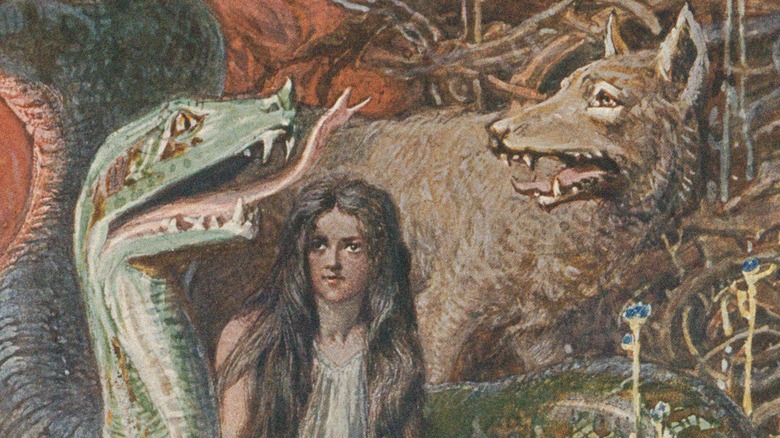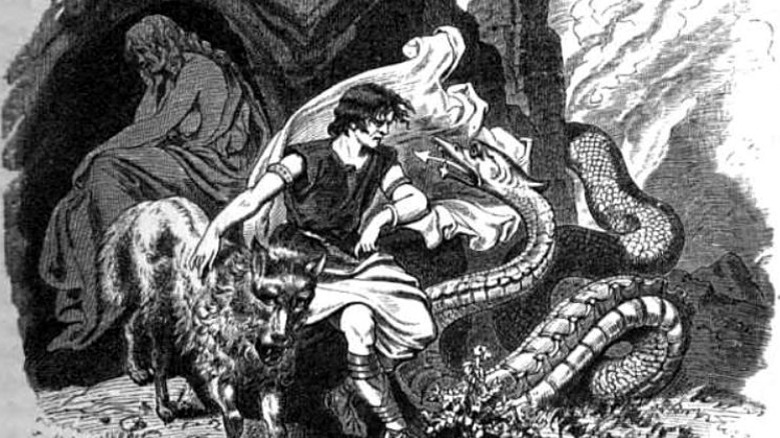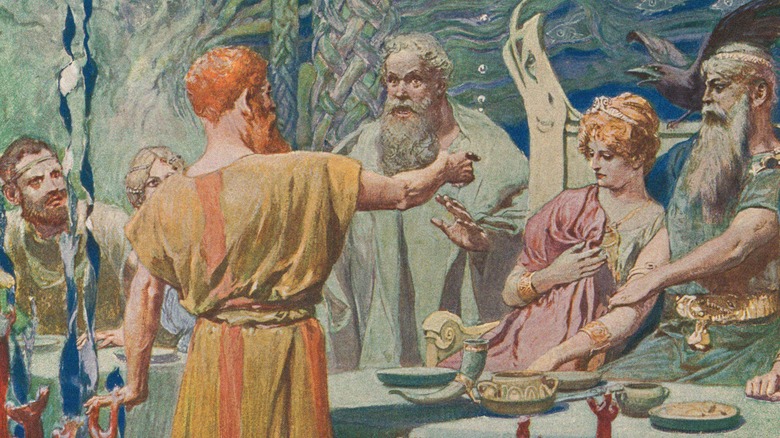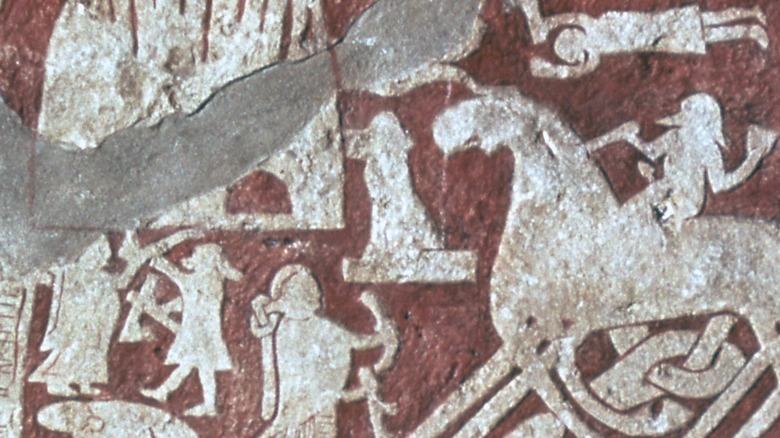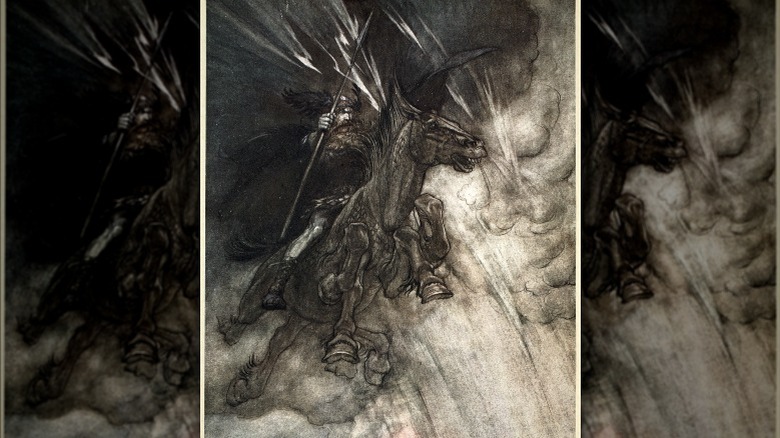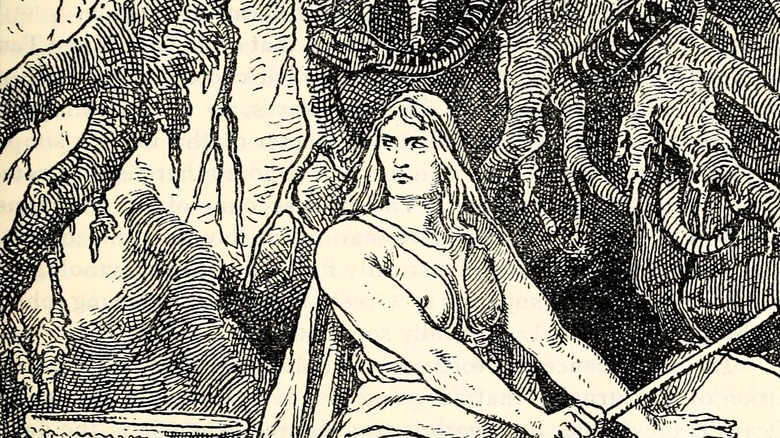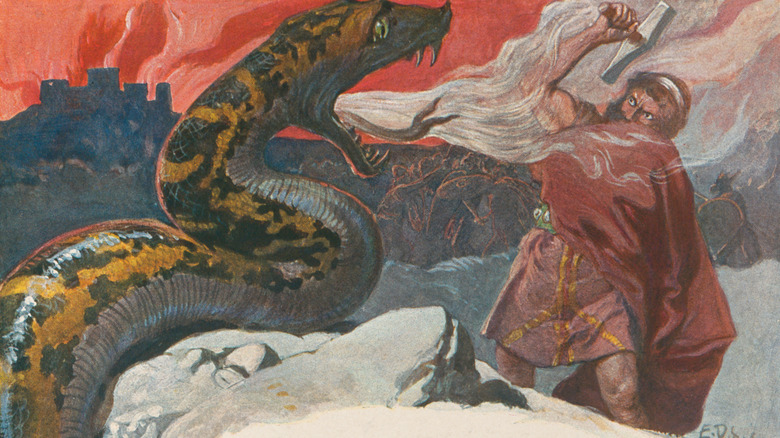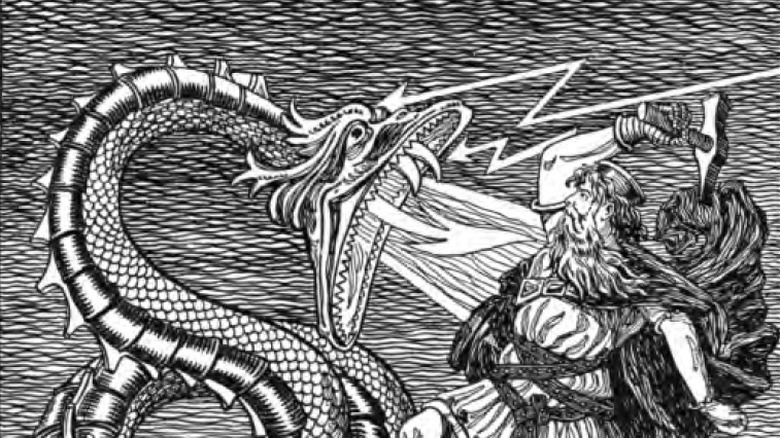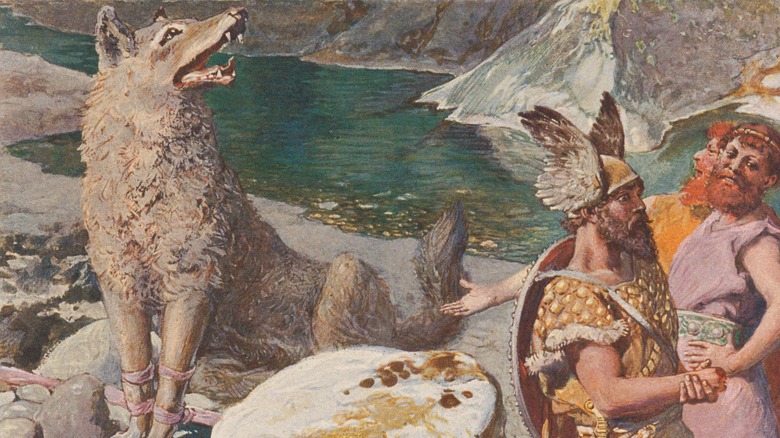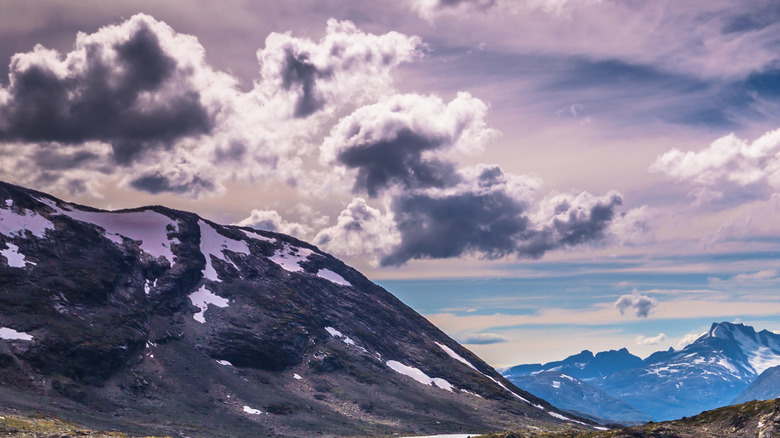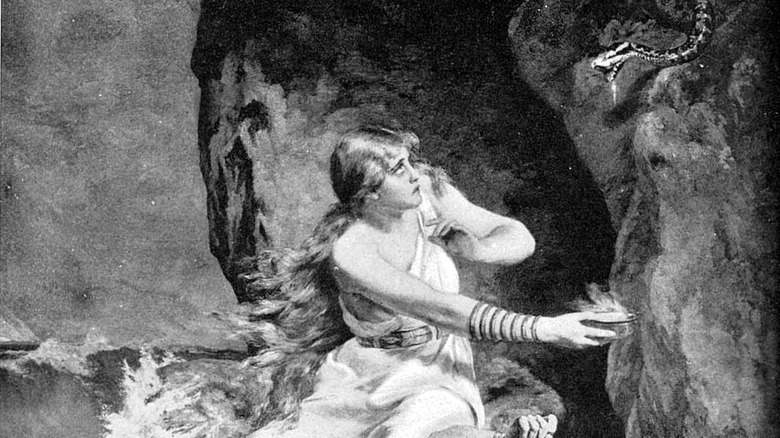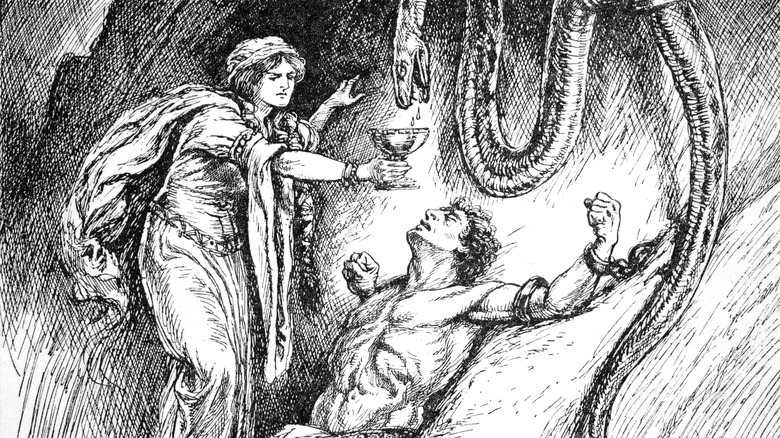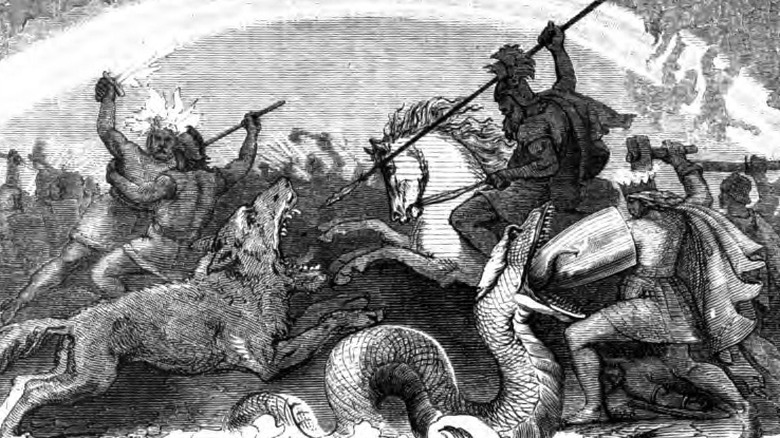The Mythology Of Loki's Monster Children Explained
Loki, the trickster god of Old Norse mythology, had many children. Some were part god, others were part giant, and one was even part horse. While none seemed to inherit Loki's ability to shapeshift, the appearances of the children were highly varied. From a ravenous wolf to a snake large enough to wrap around the entire world, each was monstrous in their own way.
As noted by Britannica, Loki's tricks were sometimes lighthearted and funny and other times malicious and deadly, depending on the particular story. While he is sometimes depicted as being allied with gods, Loki and his children were fated to be their greatest enemies. The children of Loki were believed to be at the center of an event called "Ragnarök," which would be a great battle in which many of the most famous Norse gods would be killed. Loki's most terrifying children were all prophesied to have a part to play in the doomsday of the gods.
Loki
Loki is usually depicted as handsome and clever, both in the Old Norse legendary sagas and in modern portrayals, so it may seem surprising that his children are described as chilling monsters. However, the trickster god is more monstrous than he may seem.
As retold by "D'Aulaires' Book of Norse Myths," Loki was a "Jotun" or Frost Giant. Most of the Jotun were described as terrifying and sometimes massive creatures. While Loki was portrayed as looking very different from the others, and one of his most powerful abilities may offer the explanation: Loki is a shapeshifter. In the legends, many Jotun were able to turn into animals, taking on the form of dangerous predators like wolves or eagles. Loki's unique powers allowed him to transform into any living being, regardless of species or gender.
While Loki was considered one of the Norse gods, even becoming blood brothers with their king, Odin, his origins and abilities set him apart. He often appeared in legends as a helpful companion (especially to the thunder god Thor) but some versions foretell a villainous fate for the trickster god Loki –- alongside his monstrous children.
Possible human children
Loki spent time with both gods and frost giants, but the Poetic Edda poem Lokasenna (via Sacred Texts) implies that the trickster god also spent time in the mortal world, Midgard –- and may have even had human children.
In Lokasenna, Loki crashes a party the other gods are having and proceeds to insult all the guests. After Loki mocks his blood brother Odin for past failures, the king of the gods makes an accusation about Loki's past. He claims that Loki spent eight years underground in the shape of an ordinary woman, acting as a milkmaid. Further, Odin claims that when he was in human form, Loki gave birth to human children.
It's unknown if this taunt was supposed to be a true or simply an insult. It might have been a reference to a legend about Loki that was never recorded. Regardless of any possible babies he might have had while posing as an underground milkmaid, Loki mothered at least one child -– but it certainly wasn't human.
Deal with a giant
Loki's status as one of the gods sometimes put him at odds with other Jotun. It is one of these conflicts that led to the birth of one of his most famous children.
As described in chapter XLII of the 13th century Norse Edda "Gylfaginning," a giant builder once came to the gods to strike a bargain. He claimed he could build them a great citadel before summer, with only the help of his horse. If he failed to build it before the time ran out, the gods could have the citadel for free. If he did, the gods would have to give him the sun and the moon, and the goddess Freyja for a wife. On Loki's advice, the gods accepted, believing there was no way that the builder could succeed.
The builder's horse was a magnificent stallion and was able to drag so many heavy stones that it became more and more likely that the giant would win the bet. The gods were furious, and turned on Loki for giving them bad advice. Fearing that the gods would kill him if they lost, Loki swore to prevent the builder from succeeding. Loki transformed into a stunning mare and went to meet the builder and his horse. When the stallion spotted Loki in the form of a female horse, he went wild and chased after the trickster. Without his horse, the builder lost the bet –- but Loki became pregnant by the horse.
Sleipnir
As described in "Gylfaginning," "Loki had such dealings with [the builder's horse] that somewhat later he gave birth to a foal." The foal's name was Sleipnir and is generally considered to be the only one of Loki's children that he gave birth to himself, rather than fathering. As might be expected from the child of a frost giant and a horse, Sleipnir was no ordinary equine. He had eight legs, like a spider or an octopus, and was considered the best horse to ever exist.
Loki gives Sleipnir to his blood-brother Odin, the king of the gods. As described in "Old Norse Religion in Long-Term Perspectives: Origins, Changes & Interactions," Sleipnir had the important task of carrying Odin between worlds, and bringing warriors who died in battle to Valhalla so they could spend the afterlife in Odin's hall.
There was more than one place that dead mortals could spend their afterlife in Norse mythology, however. The most nightmarish option was Hel, and it was ruled by another of Loki's children.
Hel
While Loki is described as having several monstrous children, only one was a girl. She was among the most powerful and feared figures in the Old Norse legends. Hel (or Hela) was described as resembling a corpse, with some of her skin mottled dark and some deathly pale. Odin sent her to a realm called Niflheim, described by Britannica as the land of the dead. Hel was given command over this underworld, and it would come to be known as Hel, after its ruler.
As noted by "D'Aulaires' Book of Norse Myths," she was kept company by a black rooster who never crowed and a dog who always howled. Those who died from natural causes like sickness or old age would go to Hel's domain. A massive fence, with a gate guarded by her dog kept the dead inside. Occasionally, however, she would open the gate, and the dead would wander the world of the living.
The walls of Hel's hall were sometimes described as being built from writhing snakes –- which might remind her of her beloved brother Jörmungandr.
Jörmungandr
One of the most fascinating monsters in Norse Mythology is a titanic snake named Jörmungandr -– and it is another of Loki's children.
As retold by "D'Aulaires' Book of Norse Myths," Odin threw the snake child into the sea, in hopes that it wouldn't be able to harm anyone from there. Jörmungandr thrived on the sea floor, however. It grew and grew, until it was so massive that its body stretched all the way around the human world (also known as Midgard.) By the time it was full grown, the serpent had actually outgrown the sea. Even after wrapping all the way around the earth, its tail was touching its head. Eventually its fangs were biting into its own tail.
This is an example of ouroboros, defined by Merriam-Webster dictionary as, "a circular symbol that depicts a snake or dragon devouring its own tail and that is used especially to represent the eternal cycle of destruction and rebirth."
Thor's arch nemesis
Even when young, the Midgard Serpent was so powerful that he made Odin, king of the gods, nervous. However, it was Thor, the god of thunder, who would become Jörmungandr's nemesis. In one story, Thor enters into a contest with the giants, but the giants use magic to embarrass the Thunder God. As retold in, "The Adventures of Thor the Thunder God," one of the challenges they set him is to lift a cat. Despite how strong Thor is, he finds lifting the cat impossible. In truth, it was the Midgard Serpent, transfigured to look like an ordinary house cat.
As analyzed in "Two of Thor's Great Fights according to Hymiskviða," on another occasion, Thor went on a quest where he tried to capture Jörmungandr by going fishing for the enormous snake. Some versions of this story depict Thor's attempt to kill the Midgard Serpent as more than a hero trying to slay a monster. Instead, it has been interpreted as the Thunder God attempting to prevent the end of the world, an event known as "Ragnarök" in Old Norse legends.
The giant snake was believed to have an important and devastating role to play during Ragnarök, but one of Loki's other children was destined to cause even more havoc and destruction during the end of the world: Fenrir.
Fenrir
Another of Loki's monstrous children is the wolf Fenrir. If Thor is the Midgard Serpent's nemesis, then Odin, the king of the gods, is Fenrir's. As retold in "D'Aulaires Book of Norse Myths," when Fenrir was just a pup, Odin had him taken to a secret island to keep him from doing harm. Fenrir only grew larger and more powerful. By the time Odin realized stranding Fenrir would not be enough to keep him captive, the wolf was already massive. Even the gods were not powerful enough to stop him.
The gods attempted to trick Fenrir into letting them tie him up with the magic ribbon, telling him it was just a test to see how strong he really was. Fenrir was not fooled. He told the gods he would only allow them to tie him with the ribbon if one of the gods would put a hand into his huge jaws. If he found that they had deceived him, he would bite it off. Odin's son Tyr, the god of justice agreed. He knew that the wolf would bite off his hand, but he was willing to sacrifice it to bind Fenrir.
The plan worked, and even though Fenrir ate Tyr's hand, he was successfully tied up. However, his island was near the Ironwood Forest where his mother lived, so he never went hungry. Even captive, Fenrir continued to grow bigger and more dangerous.
Angrboða
While the shapeshifting Loki was technically Sleipnir's mother, he was father to Hel, the Midgard Serpent, and Fenrir. Their mother was the giantess Angrboða. According to part XII of "Gylfaginning," she lived in the Ironwood Forest, which was inhabited by troll women. Along with her three children with Loki, Angrboða was said to have many other sons who were giants that could take the shape of wolves. As noted in, "Norse Mythology: A Guide to Gods, Heroes, Rituals, and Beliefs" her name means "she who offers sorrow," because she was the mother of so many terrifying creatures.
As told in section XXXIV of "Gylfaginning" (hosted by Sacred Texts) the gods received a prophecy about the children of Loki and Angrboða would bring them "great misfortune... from the mother's blood, and yet worse from the father's." Odin, the king of the gods, believed the prophecy and had Loki's three children taken from Jötenheim. However, as noted in "D'Aulaires' Book of Norse Myths," he had sworn to be Loki's blood brother, and could not kill Loki's children even if they were destined to bring about the end of the world. For this reason, he sent Hel to rule over the dead, threw the Midgard Serpent into the ocean, and banished Fenrir to the island.
While the most famous of Loki's monstrous children were with Angrboða, he also had children with another woman – his wife.
Sigyn
As Odin's blood brother, Loki is considered one of the Norse Gods despite being a shapeshifting Frost Giant. While the giantess Angrboða was the mother of three of his most famous children, the trickster god also had a goddess wife: Sigyn. "Norse Mythology: A Guide to Gods, Heroes, Rituals, and Beliefs" suggests that there is a "mythic past," or things that occurred before the typical legends – such as Loki's relationship with Angrboða. In the "mythic present" of the legends, Loki is married to Sigyn and is sometimes allied with the gods. In the "mythic future" of Ragnarök he will be their enemy.
As detailed by "D'Aulaires' Book of Norse Myths," Odin, the king of the gods, gave his blood brother Loki the goddess Sigyn (sometimes spelled "Sigunn") for a wife. Unlike her trickster husband, she was depicted as loyal, patient and kind. Her loyalty to her husband would cause her to share in one of his most horrendous punishments.
Sigyn and Loki had two sons named Narfi and Vali. The two appeared to be his least monstrous children, looking and behaving like ordinary gods – but their father's part in the grisly murder of a beloved god would lead to a monstrous end for them both.
Narfi and Vali
Loki is sometimes depicted as cunning and mischievous, but in other legends he is a malevolent figure who spreads chaos and death. In one famous legend, Loki tricks one of the gods into killing Odin's son Balder. As detailed in "The five great skeptical dramas of history" Loki's punishment was depicted as extremely gruesome.
Loki's sons Narfi and Vali were captured by the gods. Vali was transformed into a murderous wolf, and he instantly tore his brother into pieces. The gods took Narfi's entrails and used them to bind Loki in a cave, deep under the earth. A snake was hung from the cave ceiling, positioned so that it would drip venom into Loki's face. His wife Sigyn remained loyal, however. She remained by his side, using a cup to catch the venom. When the cup was full, Sigyn would have to leave to empty it. Loki's thrashing from the venom that hit him while she was away would cause earthquakes.
Loki was said to be trapped under the earth, bound by his son's entrails until "the Twilight of the gods" Ragnarök.
Ragnarök
The Poetic Edda (via Sacred Texts) describes the events of Ragnarök – a battle between all the gods and Loki, accompanied by his monstrous children. It is often depicted as something like a doomsday prophecy, in which many of the most powerful gods meet their ends. The knowledge that Ragnarök is coming sometimes impacts the decisions of the characters in the legends (such as Thor attempting to fish the Midgard Serpent out of the sea or Odin taking Loki's children from Angrboða.) As described by Britannica, it was believed that the years before Ragnarök would be marked by long and terrible winters and "moral chaos."
In the Poetic Edda, the giants come to make war on the gods. Loki leads all "the people of Hel" to battle in a boat made of the fingernails of the dead. The Midgard Serpent rises up from the sea to fight Thor, and both are killed in the battle. The wolf Fenrir eats Odin but is himself killed by one of the other gods. Loki dies in battle like his children.
Many scholars have linked Ragnarök with "apocalyptic sections of the Bible." Some (including the World History Encyclopedia) have suggested that the story of Ragnarök and the deaths of the gods, Loki, and his children was not part of Norse belief before Christianity.
